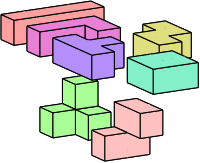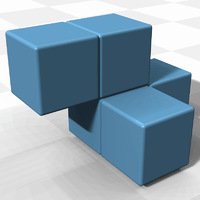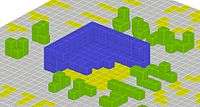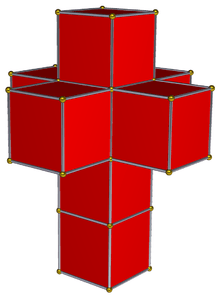Polycube



A polycube is a solid figure formed by joining one or more equal cubes face to face. Polycubes are the three-dimensional analogues of the planar polyominoes. The Soma cube, the Bedlam cube, the Diabolical cube, the Slothouber–Graatsma puzzle, and the Conway puzzle are examples of packing problems based on polycubes.[1]
Enumerating polycubes
Like polyominoes, polycubes can be enumerated in two ways, depending on whether chiral pairs of polycubes are counted as one polycube or two.[2] For example, 6 tetracubes have mirror symmetry and one is chiral, giving a count of 7 or 8 tetracubes respectively.[3] Unlike polyominoes, polycubes are usually counted with mirror pairs distinguished, because one cannot turn a polycube over to reflect it as one can a polyomino. In particular, the Soma cube uses both forms of the chiral tetracube.
Polycubes are classified according to how many cubical cells they have:[4]
| n | Name of n-polycube | Number of one-sided n-polycubes (reflections counted as distinct) (sequence A000162 in the OEIS) |
Number of free n-polycubes (reflections counted together) (sequence A038119 in the OEIS) |
|---|---|---|---|
| 1 | monocube | 1 | 1 |
| 2 | dicube | 1 | 1 |
| 3 | tricube | 2 | 2 |
| 4 | tetracube | 8 | 7 |
| 5 | pentacube | 29 | 23 |
| 6 | hexacube | 166 | 112 |
| 7 | heptacube | 1023 | 607 |
| 8 | octocube | 6922 | 3811 |
Polycubes have been enumerated up to n=16.[5]
Symmetries of polycubes
As with polyominoes, polycubes may be classified according to how many symmetries they have. Polycube symmetries (conjugacy classes of subgroups of the achiral octahedral group) were first enumerated by W. F. Lunnon in 1972. Most polycubes are asymmetric, but many have more complex symmetry groups, all the way up to the full symmetry group of the cube with 48 elements. Numerous other symmetries are possible; for example, there are seven possible forms of 8-fold symmetry [3]
Properties of pentacubes
Twelve pentacubes are flat and correspond to the pentominoes. Of the remaining 17, five have mirror symmetry, and the other 12 form six chiral pairs. The types of the flats are 5-1-1, 4-2-1, 3-3-1, 3-2-1. The 3-D types are 4-2-2, 3-2-2, 2-2-2.[6]
A polycube may have up to 24 orientations in the cubic lattice, or 48 if reflection is allowed. Of the pentacubes, two flats (5-1-1 and the cross) have mirror symmetry in all three axes; these have only three orientations. Ten have one mirror symmetry; these have 12 orientations. Each of the remaining 17 pentacubes has 24 orientations.
Octacubes and hypercube unfoldings

The tesseract (four-dimensional hypercube) has eight cubes as its facets, and just as the cube can be unfolded into a hexomino, the tesseract can be unfolded into an octacube. One unfolding, in particular, mimics the well-known unfolding of a cube into a Latin cross: it consists of four cubes stacked one on top of each other, with another four cubes attached to the exposed square faces of the second-from-top cube of the stack, to form a three-dimensional double cross shape. Salvador Dalí used this shape in his 1954 painting Crucifixion (Corpus Hypercubus)[7] and it is described in Robert A. Heinlein's 1940 short story "And He Built a Crooked House".[8] In honor of Dali, this octacube has been called the Dali cross.[9][10] It can tile space,[9] and can be unfolded to a polyomino that tiles the plane.[10] More generally (answering a question posed by Martin Gardner in 1966) among the 3811 different free octacubes, 261 of them are unfoldings of the tesseract.[9][11]
References
- ↑ Weisstein, Eric W. "Polycube." From MathWorld
- ↑ "Enumeration of Specific Classes of Polycubes", Jean-Marc Champarnaud et al, Université de Rouen, France PDF
- 1 2 Lunnon, W. F. (1972). "Symmetry of Cubical and General Polyominoes". In Read, Ronald C. Graph Theory and Computing. New York: Academic Press. pp. 101–108. ISBN 978-1-48325-512-5.
- ↑ Polycubes, at The Poly Pages
- ↑ "Dirichlet convolution and enumeration of pyramid polycubes", C. Carré, N. Debroux, M. Deneufchâtel, J. Dubernard, C. Hillairet, J. Luque, O. Mallet; November 19, 2013 PDF
- ↑ Aarts, Ronald M. "Pentacube." From MathWorld
- ↑ Kemp, Martin (1 January 1998), "Dali's dimensions", Nature, 391 (27), doi:10.1038/34063
- ↑ Fowler, David (2010), "Mathematics in Science Fiction: Mathematics as Science Fiction", World Literature Today, 84 (3): 48–52, JSTOR 27871086,
Robert Heinlein's "And He Built a Crooked House," published in 1940, and Martin Gardner's "The No-Sided Professor," published in 1946, are among the first in science fiction to introduce readers to the Moebius band, the Klein bottle, and the hypercube (tesseract).
. - 1 2 3 Diaz, Giovanna; O'Rourke, Joseph, Hypercube unfoldings that tile and , arXiv:1512.02086
 .
. - 1 2 Langerman, Stefan; Winslow, Andrew (2016), "Polycube unfoldings satisfying Conway's criterion", 19th Japan Conference on Discrete and Computational Geometry, Graphs, and Games (JCDCG^3 2016) (PDF).
- ↑ Turney, Peter (1984), "Unfolding the tesseract", Journal of Recreational Mathematics, 17 (1): 1–16, MR 765344.
External links
- An actual wooden hexacube built by Kadon
- Polycube Symmetries
- Polycube solver Program (with Lua source code) to fill boxes with polycubes using Algorithm X.